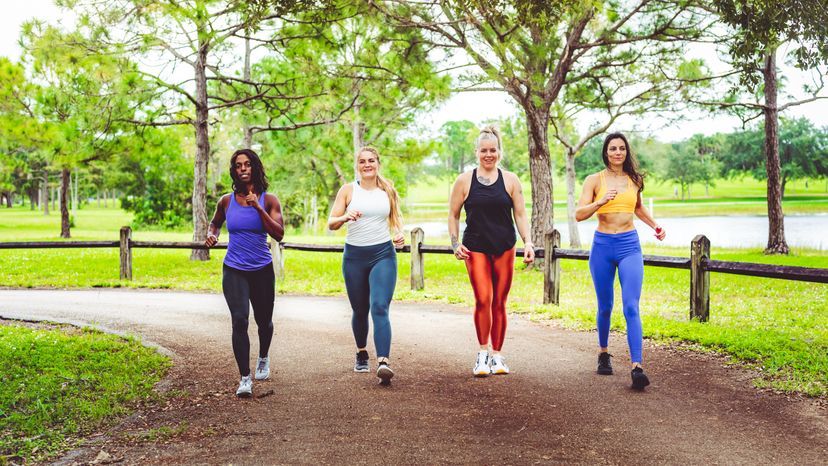Are you interested in learning to racewalk and maximizing your walking workout? Follow these steps and adopt the proper racewalking form:
- Step 1: As the body passes over the torso, the supporting leg is straight in the upright position. The opposite leg is moving forward, with the foot close to the ground. The arm is bent at a 90 degree angle.
- Step 2: The supporting leg is beginning to push the body ahead, causing the body to lean forward slightly. The opposite hip and leg are swinging forward, with the foot close to the ground. The arm above the supporting leg is beginning its upward thrust.
- Step 3: The supporting leg is exerting a strong push as the body leans forward. The opposite hip and leg are reaching forward. The arm above the supporting leg is pumping across the chest as the opposite arm pumps back.
- Step 4: In this final step, the supporting leg continues to push the body forward as the heel of the opposite foot touches the ground. Note that the foot of the supporting leg is still in contact with the ground as the back of the opposite heel makes contact. The arms are at the high point of their pumping motion.
How do you adjust your form to incorporate these features? Stand straight, with your toes aimed dead ahead. Begin walking by stepping forward with your left hip, your left knee, and your left heel. Be sure you land first on the back edge of your heel. Your left foot should be at a 90 degree angle to your left leg (your leg and foot should form the shape of a capital "L"), and your heel should be at about a 40 degree angle to the ground.
When the back edge of your heel strikes, tilt your foot ever-so-slightly toward the outer edge of your shoe; you'll be rolling on the outer edge of your foot as you shift your weight from the back to the front of your foot. This will keep your knee from rotating inward, which can cause "runner's knee."
As your left leg lands and begins to pull you forward, give yourself a strong pushoff with your right foot. As your right foot leaves the ground and begins to swing forward, your torso will pass directly over your left leg. At that moment, your left leg must be straight. Once your torso has passed directly over your left leg, your left leg will push you forward until the back of your right heel strikes the ground.
You should keep a few things in mind as you practice this technique. First, be sure to keep your toes pointing straight ahead as you walk. If you don't, you'll be moving from side to side as well as forward, wasting energy and losing speed.
Second, pay attention to foot placement. In freestyle walking, your feet land about shoulder-width apart (in the side-to-side direction). In racewalking, your feet should line up one behind the other.
To practice this, try walking an imaginary straight line (or draw a straight line on the pavement with chalk). As you extend each leg forward, try to plant it on the line, or as close to the line as possible. This will keep you from waddling and give you a smooth, efficient stride.
Third, when your supporting leg is straight, the hip above it should rise and relax. This will let the bones of the leg support the weight and give the muscles a break. This hip movement can be somewhat hard to achieve at first, particularly for men who are "trained" to believe that mobile hips are feminine-looking. But the hip movement is crucial to the racewalker, because it makes the stride as smooth as possible. Also, as you swing the nonsupporting leg forward, be sure to swing the hip above it forward, too.
Finally, as you walk, you should feel yourself leaning forward from the ankles. Don't bend forward at the waist, however. This will strain your back and neck and could hamper your breathing.
In addition to using your legs and hips correctly, you need to get your arms in on the act. As in freestyle walking, your arms will naturally swing to counterbalance your legs. But if you consciously and vigorously pump your arms, you can actually help your legs move faster.
To get the most benefit, keep your arms bent at right angles. Pump your arms diagonally across the center of your body, keeping your elbows close to your sides. Don't pump your arms too high, however -- chest-high is enough.
By using proper form when you racewalk, you avoid the risk of injury. Stretching is equally important. The next section has important stretching and other safety tips.
To learn more about walking, see:
